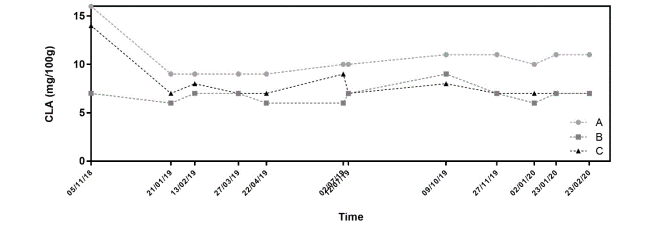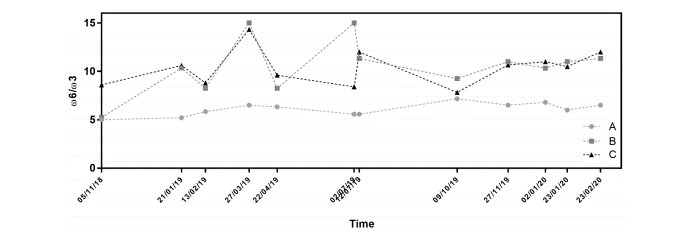INTRODUCTION
Milk is considered a drink of choice, widely consumed and essential for the diet of billions of people worldwide. In addition to its primary role, feeding newborns, milk is consumed by individuals of all age groups, due not only to its pleasant sensory characteristics, but also for the purpose of improving well-being and health in general (1). Cow's milk is the leader in the global milk production representing 83 % of the total milk production (2). Milk is considered an important source of nutrients, with protein, minerals, fats, carbohydrates and vitamins in its composition. For this reason, cow's milk is considered a high-quality food for human nutrition (3).
Excluding water, fat represents one of the main components of cow’s milk, having as main functions to serve as a source of energy and to be a source of essential fatty acids (3, 4). About 98% of the fat fraction of milk consists of triacylglycerols (TAG), while lipids such as diacylglycerols, cholesterol, phospholipids and free fatty acids can also be found in much lower percentages (below 2%) (5-7). Triacylglycerols can be structurally classified into two distinct groups, the saturated ones, which represent a total of 70%, and the unsaturated ones, which complete the remaining 30%. Unsaturated fatty acids are further subdivided into monounsaturated and polyunsaturated, including the vaccenic acid, omega-3 (ω3), omega-6 (ω6) and the conjugated linoleic acid (CLA) (3).
The presence of unsaturated fatty acids in human diet has been associated with benefits in human health. Specifically, CLA has been found to have hypocholesterolemic and anti-atherogenic properties, an immunostimulant effect and an antioxidant role (8-12).
Also, the ω3 and ω6 influence human health in many ways. The deficiency of some ω3 and ω6 can affect memory, learning and vision. Moreover, some have positive effects on cardiovascular and neurodegenerative diseases and have shown to have anti-inflammatory properties (13). With the current dietary practices, the optimal ω6/ω3 ratio is 4:1 (14, 15).
The fatty acid composition of cow’s milk is influenced by animal factors (breed, genetics, lactation status) and feed factors (diet and farm management practice) (11,16-18).
Scientific studies demonstrate that milk fat is very sensitive to the diet that cows are subjected to. Animals that eat fresh grass in greater quantity produce milk with a lipidic profile more beneficial to human health, particularly concerning the increased concentrations of some hypocholesterolemic unsaturated fatty acids (19). It has been proved that animals that have access to fresh forage in larger quantities produce milk with a lower ω6/ω3 ratio and it is therefore closer to the recommended (20, 21).
Also, milk from pasture-based feeding systems can contribute to controlling environmental problems such as gas emissions and the contamination of aquatic environments since an suitable diet allows the reduction of methane emissions and mitigates the environmental pollution of nitrogen by the production of cow’s milk (22).
This feeding system also allows animals to remain freely in their natural habitat, the pastures, instead of being enclosed in small compartments, feeding on rations, such as in conventional intensive feeding systems (23). Even if carried out only during part of the day, the pasture is a more sustainable practice, has a positive effect on the health of animals, can reduce environmental damage, improve the nutritional quality of milk and also contributes to improve human health (23, 24).
Thus, the development of studies that contribute to a global database that allows distinguishing the different milks from different regions/ countries is of great relevance because it will allow to identify the main differences between the milks and the main factors that influence the composition of cow’s milk allowing the development of more controlled and improved milk production.
OBJECTIVES
The main objective of this work is to compare the effect of two different feeding systems, pasture-feeding systems and conventional-feeding systems (intensive indoor), on the lipidic profile of cow’s milk produced in Portugal, namely in terms of the concentration of CLA and the ω6/ ω3 ratio. Additionally, this work aimed to evaluate the variation of these parameters through the sampling period.
METHODOLOGY
In order to determine whether pasture milk (A) has better properties than milk obtained through conventional systems (B, C) throughout the year, specifically regarding the CLA concentration and the ω6/ω3 ratio, 12 milk samples from each brand of semi-skimmed UHT milk produced in Portugal were collected by GO LIVE!, Portugal between 2018 and 2020 in different days, englobing the different seasons. The samples were previously analyzed by SILLIKER PORTUGAL, S.A., Portugal. The CLA, ω6, ω3 and ω6/ω3 ratio were determined according to ISO 15885:02.
The CLA concentration and ω6/ω3 ratio values obtained are presented with the means of the 12 samples and respective standard deviations. One-way ANOVA applying Tukey's multiple comparisons test were performed using GraphPad Prism 7.0 software (GraphPad Software, California, USA) to estimate significant differences (p<0.05) among samples with a confidence interval of 95%.
RESULTS
The nutritional compositions of milks A (pasture milk), B and C (conventional milks) were evaluated comparatively using results obtained from samples taken over various months. In order to determine if pasture milk has differences in composition compared to milk obtained from conventional systems, the CLA concentration and the ω6/ω3 ratio, that are proven to have beneficial properties to human health, were analyzed.
The concentration of CLA present in the different milks (A, B and C) as well as its variation over 3 years (2018, 2019 and 2020) were analyzed and a graph was performed for easier comparison (Figure 1). The results demonstrated that the CLA concentration in the milk A, the pasture milk, is always higher and presents a more constant profile throughout the sampling period. For milk A, the average is 10.5 mg/100g of CLA, being 53.6 % higher than that of milk B (6.8 mg/100g) and 32.6% higher than that of milk C (7.9 mg/100g). In comparison to milk A, milks B and C present a higher variation of the CLA concentration which is graphically visible (Figure 1).
The ω6/ω3 ratio of the different milks and its variation were also analyzed over the same 3 years and the results are presented in a graph for easier analysis (Figure 2). It is graphically observed that the most constant profile regarding the ω6/ω3 ratio belongs to milk A. Moreover, milk A has lower ratio values in all the samples taken over the 3 years of analysis. The average ω6/ω3 ratio from milk A is 6.1, being 42.2% lower than that of milk B (10.5) and 41.3% lower than that of milk C (10.4). Moreover, milks B and C present high variation through the period of analysis (Figure 2).
The results of the statistical analysis performed (Table 1) indicates that milk A is statistically different from milk B and C both in the average CLA concentration and in the average ω6/ω3 ratio, with milk B and C do not indicate statistically significant differences between them.
DISCUSSION OF THE RESULTS
Milk is a drink of election in human diet. Nowadays, society is more concerned with health and, consequently, the demand for food with greater health benefits has increased (25).
CLA has been reported to have several advantages to human health (8-12). Since CLA cannot be synthesized by human metabolism it can only be obtained by consuming meat and/or dairy products (26). In this way, milk represents an important aliment for the obtention of CLA. O'Callaghan et al. (24) in a study to compare the effects of different feeding systems on milk quality and composition show that milk from pasture-feeding systems has a CLA concentration over 2-fold higher. Similar to that study, the present work shows that pasture milk not only has higher values of CLA concentration through the time of analyses, but also a more constant profile.

Figure 1: A: Milk obtained through pasture-feeding system B and C: Milk obtained through conventional system (intensive indoor) Concentration of conjugated linoleic acid (CLA) over the sampling period from 2018, 2019 and 2020

Figure 2: A: Milk obtained through pasture-feeding system B and C: Milk obtained through conventional system (intensive indoor) Omega-6/omega-3 ratio (ω6/ω3) over the sampling period from 2018, 2019 and 2020
Table 1: Conjugated linoleic acid (CLA) concentration and ω6/ω3 ratio

The values are represented as mean ± SD (n=12). Statistical analysis was performed using One-way ANOVA Tukey's multiple comparisons test. The same letters represent no significant differences at the 95% confidence level.
A: Milk obtained through pasture-feeding system
B and C: Milk obtained through conventional system (intensive indoor)
In recent years the ω6/ω3 ratio in dietary products has received much attention. The optimum intake of ω6/ω3 ratio is 4:1, however the current diet increases the ω6 to undesirable levels, coinciding with an increase of inflammatory-related diseases (27). Thus, it is extremally important to human health that people consume products with a recommended ω6/ω3 ratio.
The results obtained in the present work show that pasture milk has a more proximal ω6/ω3 ratio to the recommended and is less affected by the different factors that interfere with milk composition, since it presents a more constant profile. This result is supported by a study conducted by Benbrook et al. (28) where it is shown that pasture milk has less ω6, resulting in a ω6/ω3 ratio more proximal to the recommended. O'Callaghan et al. (24) has similar results. Taking into account the benefits that CLA and a recommended ω6/ω3 ratio have in human health and also the data analysis performed in this work it is possible to affirm that the pasture milk produced in Portugal has more nutritional interest than the milk obtained in the conventional systems Since at the time of this study there was only one milk produced through pasture-feeding system in Portugal, it was intended to compare this pasture milk with two brands of conventionally produced milk well established on the market. This study contributes to a global database that allows to verify that the only milk produced in Portugal through pasture-feeding system (at the date of the study) has a composition more favorable to human health with evidences that the fatty acids profile of milk could be improved by pasture-feeding systems. Moreover, pasture allows the cows to have a more natural environment and, consequently, the expression of their normal behavior (24). Thus, the milk obtained from pasture-feeding systems is considered more natural since it increases the welfare of the animal and the protection of the environment.
CONCLUSIONS
This study allows the composition of the effect of two feeding systems in the lipidic profile, specifically, on the CLA concentration and the ω6/ ω3 ratio over 3 years of sampling. In conclusion, the pasture-feeding system has been shown to produce milk with a composition that seems to have more health benefits and with a more constant composition over time, when compared with conventional-feeding systems. The pasture milk has an increased CLA concentration and a ω6/ω3 ratio more proximal to the recommended. Thus, this study indicates the possibility of the fatty acids profiling of milk being improved by pasture feeding systems.














